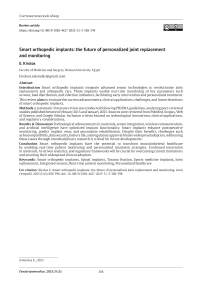Smart orthopedic implants: the future of personalized joint replacement and monitoring
Автор: Kirolos E.
Журнал: Гений ортопедии @geniy-ortopedii
Рубрика: Обзорная статья
Статья в выпуске: 3 т.31, 2025 года.
Бесплатный доступ
Introduction Smart orthopedic implants integrate advanced sensor technologies to revolutionize joint replacement and orthopedic care. These implants enable real-time monitoring of key parameters such as wear, load distribution, and infection indicators, facilitating early intervention and personalized treatment. This review aims to evaluate the current advancements, clinical applications, challenges, and future directions of smart orthopedic implants. Methods A systematic literature review was conducted following PRISMA guidelines, analyzing peer-reviewed studies published between February 2015 and January 2025. Sources were retrieved from PubMed, Scopus, Web of Science, and Google Scholar. Inclusion criteria focused on technological innovations, clinical applications, and regulatory considerations. Results & Discussion Technological advancements in materials, sensor integration, wireless communication, and artificial intelligence have optimized implant functionality. Smart implants enhance postoperative monitoring, predict implant wear, and personalize rehabilitation. Despite their benefits, challenges such as biocompatibility, data security, battery life, and regulatory approval hinder widespread adoption. Addressing these issues through interdisciplinary research is critical for future developments. Conclusion Smart orthopedic implants have the potential to transform musculoskeletal healthcare by enabling real-time patient monitoring and personalized treatment strategies. Continued innovation in materials, AI‑driven analytics, and regulatory frameworks will be crucial for overcoming current limitations and ensuring their widespread clinical adoption.
Smart orthopedic implants, Spinal implants, Trauma fixation, Sports medicine implants, Joint replacement, Integrated sensors, Real-time patient monitoring, Personalized healthcare
Короткий адрес: https://sciup.org/142244816
IDR: 142244816 | DOI: 10.18019/1028-4427-2025-31-3-388-398
Текст научной статьи Smart orthopedic implants: the future of personalized joint replacement and monitoring
Smart orthopedic implants represent a significant advancement in medical technology, combining therapeutic functions with diagnostic capabilities to enhance patient care. These implants are designed to monitor various physiological parameters in real-time, providing valuable data that can inform treatment decisions and improve outcomes [1]. By integrating sensors and communication technologies, smart implants can detect changes in pressure, force, strain, displacement, proximity, and temperature within the body, offering insights that were previously unattainable through traditional methods [2].
The evolution of orthopedic implants has been marked by a transition from purely mechanical devices to sophisticated systems capable of interactive functions. Traditional implants primarily served structural roles, such as replacing or supporting damaged bones and joints [3]. However, advancements in materials science, sensor technology, and wireless communication have enabled the development of smart implants that not only fulfill structural requirements but also monitor the biological environment. For instance, modern smart implants can measure mechanical loads and stresses, providing data on how the implant interacts with the surrounding tissues during different activities [4]. This information is crucial for assessing implant performance and longevity.
Beyond joint replacement, smart orthopedic implants are being explored for applications in spine surgery, trauma fixation, and sports medicine. Personalization in joint replacement has become increasingly important as it allows for treatments tailored to individual patient needs. Smart implants facilitate this by providing continuous, patient-specific data that can guide personalized rehabilitation protocols and postoperative care [5]. For example, sensors within the implant can monitor the healing process and detect early signs of complications, such as infection or implant loosening, enabling timely interventions. This personalized approach not only enhances patient outcomes but also contributes to more efficient healthcare delivery by reducing the incidence of complications and the need for revision surgeries [6].
To ensure a comprehensive evaluation, this review follows a systematic methodology, incorporating studies from a diverse range of orthopedic specialties. By analyzing the latest technological advancements, clinical applications, and emerging challenges, this review provides a holistic overview of the role of smart orthopedic implants in modern medicine.
This review aims to evaluate the current advancements, clinical applications, challenges, and future directions of smart orthopedic implants.
METHODOLOGY
To conduct this comprehensive literature review on smart orthopedic implants, a systematic and structured approach was employed to ensure thorough and unbiased coverage of relevant research. The methodology adhered to the Preferred Reporting Items for Systematic Reviews and Meta-Analyses (PRISMA) guidelines to enhance transparency and reproducibility. The steps of the methodology are detailed below:


